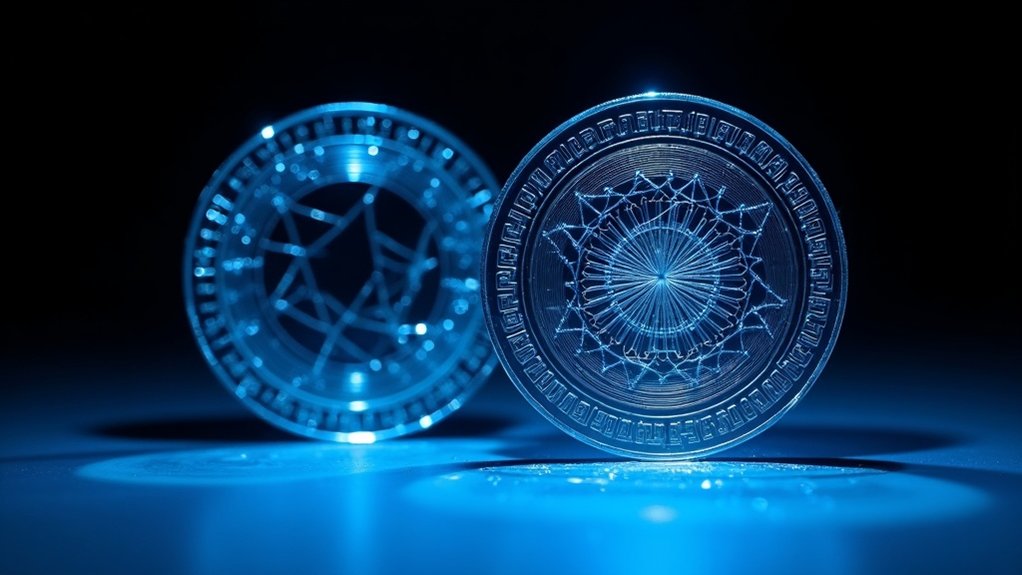Polygon is Ethereum’s life-saving Layer-2 solution. It tackles the blockchain’s notorious sluggishness and wallet-draining fees through sidechains that process transactions in parallel. Running on Proof-of-Stake, Polygon ditches energy-hungry mining while maintaining Ethereum compatibility. Its POL tokens power governance, staking, and minimal transaction fees. With speeds reaching 65,000 transactions per second and near-zero costs, Polygon makes crypto usable again. The ecosystem’s explosive growth proves scaling solutions aren’t just nice—they’re necessary.
Ethereum has issues. Big ones. It’s slow, expensive, and utterly incapable of handling the traffic needed for mainstream adoption.
Enter Polygon, the Layer-2 scaling solution that’s giving Ethereum room to breathe.
Formerly known as Matic Network, Polygon functions like Ethereum’s efficient assistant, processing transactions on separate sidechains and only periodically syncing with the main network.
Polygon’s architecture is pretty clever. While Ethereum struggled with its old-school Proof-of-Work system, Polygon embraced Proof-of-Stake from the start.
Validators stake POL tokens (previously called MATIC) to secure the network and process transactions.
No energy-wasting mining required.
The result? Lightning-fast transactions at a fraction of Ethereum’s cost.
We’re talking potentially 65,000 transactions per second versus Ethereum’s laughable 15.
The technical stuff gets interesting. Polygon uses sidechains that run parallel to Ethereum, taking pressure off the main network.
These sidechains commit their transaction summaries to Ethereum via checkpoints using Merkle roots.
They’ve also incorporated advanced scaling tech like Plasma, Optimistic Rollups, and Zero-Knowledge proofs.
The new Polygon 2.0 upgrade introduces zero-knowledge proofs for faster and more secure cross-chain transactions without Ethereum mainnet involvement.
Sounds fancy, right? It is.
POL tokens are the network’s lifeblood. They’re used for governance, staking, and paying those minimal transaction fees.
Holders can stake tokens to earn rewards while supporting network security.
The token also powers the Polygon Bridge, allowing assets to move between Polygon and Ethereum without breaking a sweat.
Developers love Polygon because it’s fully compatible with Ethereum smart contracts. The Polygon SDK further empowers developers to create custom blockchain networks that integrate seamlessly with Ethereum’s infrastructure.
No need to rewrite code.
Just port your dApp over and enjoy the speed.
This compatibility has attracted an ecosystem spanning DeFi protocols, NFT marketplaces, games, and DAOs.
The network has impressively processed over 4 billion transactions since its inception, demonstrating its robust adoption and reliability in the blockchain space.
For users, the difference is night and day.
Near-instant finality, negligible fees, and smooth performance make Polygon ideal for gaming, DeFi, and NFT transactions.
No more watching gas fees for hours, waiting for prices to drop.
Just fast, cheap transactions.
Ethereum needed this.
Frequently Asked Questions
How Does Polygon Compare to Other Layer 2 Scaling Solutions?
Polygon stands out from other Layer 2 solutions through its multi-approach strategy.
While Optimism and Arbitrum rely solely on optimistic rollups with week-long withdrawal periods, Polygon offers both PoS sidechains and zkEVM solutions.
The zkEVM provides near-instant finality versus the 7-day wait competitors require.
Transaction costs? Lower than Ethereum mainnet.
Speed? Around 7,000 TPS compared to Ethereum’s measly 15-30.
Flexibility is Polygon’s game—developers get options, not limitations.
What Are the Risks of Investing in MATIC Tokens?
Investing in MATIC tokens comes with serious baggage.
Price volatility is brutal—an 85% drop from its all-time high speaks volumes.
The SEC’s breathing down Polygon’s neck, questioning if it’s an unregistered security.
Not great.
Competition’s fierce too. Arbitrum and Optimism are nipping at its heels while Ethereum upgrades might make Layer-2s less necessary.
User retention? Spotty at best. Network performance? Inconsistent.
The crypto world’s unpredictable. MATIC isn’t immune to that reality.
Can Polygon Operate Independently if Ethereum Fails?
Technically, Polygon could continue processing transactions if Ethereum failed.
It has its own validator network and consensus mechanism.
But reality check: it’d be severely crippled.
Without Ethereum’s security backbone, Polygon would lose its trusted settlement layer and transaction finality.
The bridge between networks? Kaput.
Users would face higher risks of invalid transactions, and confidence would plummet.
Think of it like a satellite that suddenly lost its planet. Functional? Maybe. Reliable? Hardly.
How Will ETH 2.0 Affect Polygon’s Future Relevance?
Ethereum 2.0 won’t kill Polygon’s relevance—not by a long shot.
While Eth2 improves base layer throughput, Polygon’s lightning-fast 65,000 TPS and microscopic $0.001 fees remain unmatched.
Sure, Ethereum’s getting faster, but it’s nowhere near Polygon territory.
They’re more likely to become collaborative partners than competitors.
Eth2 creates a stronger foundation, and Polygon builds highways on top of it.
Different jobs, same ecosystem. Complementary, not competitive. Simple as that.
What Blockchain Projects Have Successfully Migrated From Ethereum to Polygon?
Several major projects have jumped ship to Polygon.
Enegra Group Ltd moved its $28 billion EGX tokens to slash gas fees. Smart move.
Numerous DeFi applications followed suit, seeking faster transactions and lower costs.
Aavegotchi, OpenSea, and Decentraland all established presence on Polygon.
The migration pattern is clear: businesses want scalability without breaking the bank.
Polygon’s Ethereum compatibility makes the switch relatively painless.
Companies keep their core functionality while ditching the high transaction costs.









